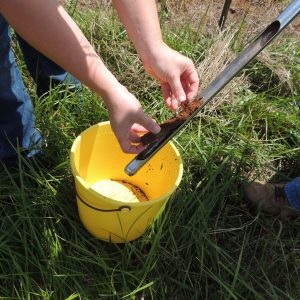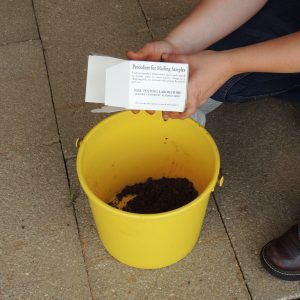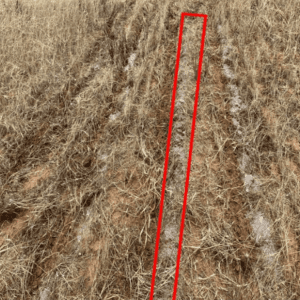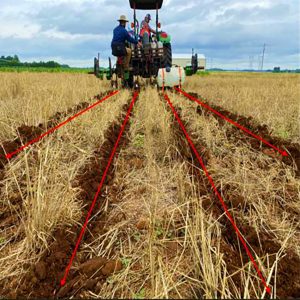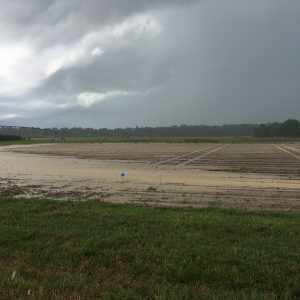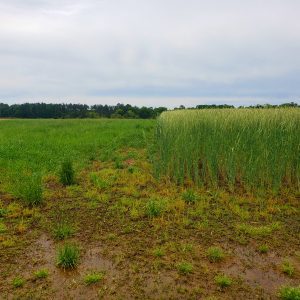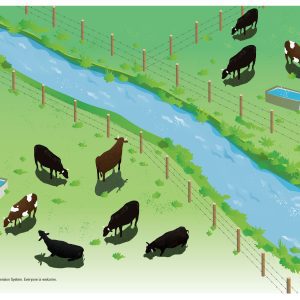Crop Production

Part of the Phosphorus Management series, this article provides information about best management practices (BMPs) of phosphorus use and how they can help reduce the environmental footprint of phosphorus to protect water quality.
Phosphorus is one of the most limiting nutrients in crop production. However, excessive phosphorus application via manure or chemical fertilizer results in a buildup of phosphorus in the soil. Phosphorus from agricultural soils can move into water bodies through surface runoff, leaching, or subsurface flow (find more information about phosphorus loss pathways in Extension publication “Phosphorus Basics: Understanding Pathways of Soil Phosphorus Loss,” ANR-2662). It is also the key driver for the deterioration of water quality. The accumulation of nutrients in water bodies, also referred to as eutrophication, restricts water use for fisheries, recreation, and industries due to the increased growth of undesirable algae and aquatic weeds. Adopting BMPs can help reduce and retard phosphorus mobility during runoff or leaching events and preserve the water quality.
What Are Best Management Practices (BMPs)?
The US Environmental Protection Agency introduced the concept of best management practices (BMPs) for reducing the pollution generated by nonpoint sources. Every state defines BMPs based on the circumstances and local conditions. Florida defines BMPs, by law, as a means, a practice, or a combination of practices developed based on research, field testing, and expert review to be the most effective and practicable that producers can follow to improve water quality while maintaining agricultural production (adapted from the Florida Department of Agriculture and Consumer Services). In Alabama, BMPs for nutrient management are based on national standards such as Code 590, which defines managing rate, source, placement, and timing of plant nutrients and soil amendments while reducing environmental impacts. Best management practices are voluntary or mandatory and have been found effective and practical for reducing movement of nutrients and sediments or other pollutants from land to water bodies.
Best Management Practices to Reduce Phosphorus Loadings to Water Bodies
Best management practices to prevent phosphorus loss are developed to minimize phosphorus transport via erosion, runoff, and leaching. The soil type, phosphorus source, application rate, field history, climate, and other management factors are vital in determining the BMPs to be selected and implemented. Producers already use many practices to reduce phosphorus loss, including adopting cover crops, implementing the four R’s (right source, right time, right rate, right placement), observing setback distances, etc. The BMPs that can help reduce phosphorus loss are as follows.
Phosphorus application based on soil test. A soil test should be used as a guiding principle to determine phosphorus application rates (figure 1). Alabama soil tests fall under six phosphorus fertility ratings: very low, low, medium, high, very high, and extremely high. If the soil test falls under the extremely high category with high negative soil phosphorus storage capacity values, focus management on soil phosphorus mining (find more information about soil phosphorus storage capacity in Extension publication “Phosphorus Management: Use of Soil Phosphorus Storage Capacity,” ANR-2739). If the phosphorus level on the surface (0 to 6-inch depth) indicates an extremely high soil test and negative soil phosphorus storage capacity, practice strip tillage to allow vertical mixing of soils. However, if the soil test falls under a high category and soil phosphorus storage capacity is positive, focus phosphorus application on crop removal amount. On the contrary, if the soil test falls under the medium or low category, base the phosphorus application strategy on buildup and maintenance.
- Figure 1a. Soil sampling for routine laboratory analysis.
- Figure 1b. Soil sampling for routine laboratory analysis.
- Figure 2. Banding fertilizer 3 to 4 inches away from the seedbed.
- Figure 3. Phosphorus injection at 6-inch depth.
Phosphorus placement. Fertilizer should be incorporated, banded, or deep banded 3 to 4 inches from the seed (figure 2). Variable rate application of phosphorus should be practiced if certain field areas are phosphorus limiting or have excessive phosphorus. Subsurface injection of phosphorus (figure 3) can also be followed in areas where the phosphorus concentration is vertically stratified with a high concentration near the soil surface and the concentration abruptly drops down in the soil profile.
Application timing. Phosphorus application should be timed to meet crop requirements. Avoid it in the fall when the ground is bare and tropical storms generate surface runoff or leaching. Avoid phosphorus application if a heavy rainfall event is predicted. The potential for phosphorus loss peaks immediately following phosphorus application and then declines over time as the applied phosphorus interacts with the soil and is converted from soluble to increasing fixed forms. The best time to apply phosphorus is before planting crops or near the spring green-up in pastures.
Phosphorus source. Phosphorus can be applied via chemical fertilizer or organic (such as manure) forms. For chemical fertilizers, refer to the practices discussed above. If the phosphorus source is manure and is used every year, the application rate is determined based on the nutrient management plan. The nutrient management plan is a decision- making tool that relies on soil tests, phosphorus index, and crop nutrient requirements based on expected yield, which helps identify fields that need nutrients and those that do not.
Manure management. Fields receiving manure should consider the following BMPs.
- Test manure to determine its nutrient concentration.
- Test soil to determine if the fields qualify for manure application.
- Determine the phosphorus index to identify the risk of phosphorus loss.
- Avoid manure application before the prediction of heavy rainfall.
- Calibrate the spreader to ensure that the application matches the intended application rate (figure 4).
- Avoid fall application of manure on bare grounds. The best time for manure application is spring green-up or 2 to 3 weeks before planting to help reduce phosphorus loss risk and give maximum benefits to crops. Phosphorus loss risk can also be minimized by injecting manure below the surface or incorporating the manure within 48 hours of a surface application.
- Avoid manure application on steep slopes where runoff potential is high.
- Avoid overirrigation to prevent phosphorus loss via runoff or leaching (figure 5).
- Observe setback distances (table 1).
- Move or sell manure off the farm if phosphorus imbalance is high.
- Adopt erosion and runoff control practices if needed.
- Figure 4. Calibrating the poultry litter applicator before spreading the litter on land.
- Figure 5. Overirrigation can result in flooding and nutrient loss.
- Figure 6. Cover crops prevent erosion and keep soil from washing away.
- Figure 7. Fencing prevents animals from getting into the water. A vegetative strip along the streamlines prevents direct entry of nutrient-rich water into the stream.
Practices to reduce phosphorus loss through soil erosion:
- Adopt no-till or minimum tillage if the soil has a high risk of sediment loss.
- Adopt conservation practices such as cover crops (grasses, legumes, or small grains) to reduce erosion and runoff (figure 6).
- Install vegetative filter strips to trap and filter sediments from surface runoff.
- Maintain a grassed waterway, riparian zones, or constructed wetlands to trap eroded phosphorus.
- Adopt stream bank stabilization to minimize erosion.
- Avoid overgrazing and grazing close to a stream. Fencing prevents animals from getting into water streams (figure 7).
Table 1: Setback Distances for Manure Application in Alabama*
* Adopted from the Alabama Department of Environmental Protection
| Property type | Setback distances for land application for animal feeding operations |
|---|---|
| Property line | Cannot cross a property line |
| Public use area or nonowner existing occupied1 | 100′ for dry waste 200′ for liquid waste 500′ for spray |
| Water or sinkholes | 200′ public supply water 200′ outstanding water |
| Well | 100′ nonpotable well or water supply |
| Road | Cannot be applied on the road |
| Frequently flooded soil | Cannot be applied on frequently flooded soil |
Conclusion
Best management practices are conservation measures developed to reduce or prevent water pollution. Implementation of BMPs can significantly help reduce phosphorus loss from agricultural soils. It should be used along with crop production and not as a remedial measure once the soil becomes a source of high phosphorus loss. Periodically monitor the efficacy of the BMPs to ensure their functionality.
Additional Resources and Suggested Reading
- Chakraborty, D., R. Prasad and E. Brantley. 2020. Phosphorus basics: understanding pathways of soil phosphorus loss. Alabama Extension publication ANR-2662, Phosphorus Basics: Pathways of Soil Phosphorus Loss
- Chakraborty, D., and R. Prasad. 2021. Phosphorus management: use of soil phosphorus storage capacity. Alabama Extension publication ANR- 2739
- Agricultural best management practices. Florida Department of Agriculture and Consumer Services.
- Alabama Department of Environmental Management. ADEM AFO-CAFO comprehensive WMSP information review checklist
 Debolina Chakraborty, Research Fellow; Rishi Prasad, Extension Specialist, Assistant Professor, both in Crop, Soil, and Environment, Auburn University
Debolina Chakraborty, Research Fellow; Rishi Prasad, Extension Specialist, Assistant Professor, both in Crop, Soil, and Environment, Auburn University
New June 2023, Phosphorus Management: Best Management Practices for Minimizing Phosphorus Loss from Agricultural Soils, ANR-3010


